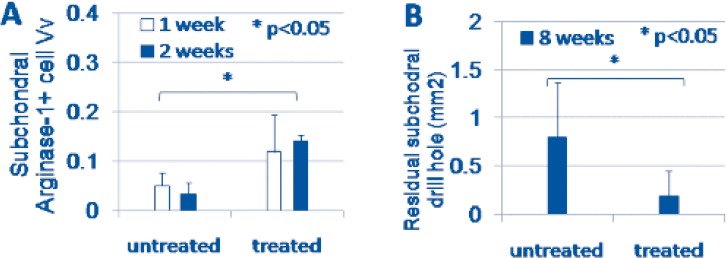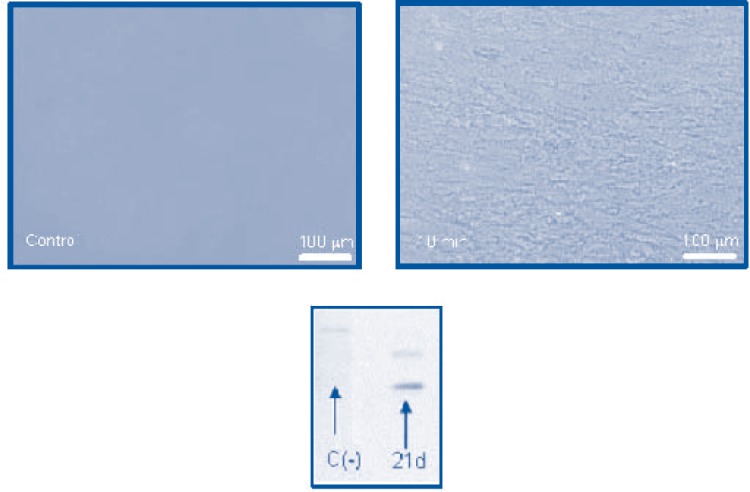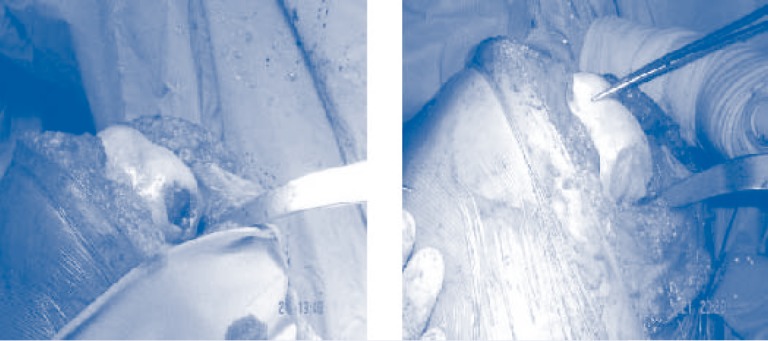Abstract
Articular cartilage in adults has a limited capacity for self-repair after a substantial injury. In addition to bone marrow stimulating procedures such as microfracturing surgical therapeutic efforts to treat cartilage have focused on delivering new cells capable of chondrogenesis into the lesions. In the classic autologous chondrocyte transplanation (ACT) technique chondrocytes are isolated from small slices harvested from a minor weight-bearing area of the injured knee. The extracted cells are then cultured and once a sufficient number of cells has been obtained, the chondrocytes are implanted into the cartilage defect using a periosteal patch over the defect as a method of cell containment. Further improvements in tissue engineering have contributed to the next generation of ACT techniques, where cells are combined with resorbable biomaterials, as in matrix associated autologous chondrocyte transplantation (MACT). These materials secure the cells in the defect area and enhance their proliferation and differentiation.
MR imaging as a non-invasive technique is the method of choice in the preoperative evaluation and follow-up of patients with these different surgical cartilage repair techniques.
MR imaging of the morphology of cartilage and cartilage repair tissue has significantly improved in recent years due to the development of clinical high-field MR systems operating at 3 Tesla. The improved performance has also been achieved as a result of the higher gradient strengths and the application of dedicated coils with modern configuration such as phased array coils.
MR should be performed with cartilage sensitive sequences such as fat-suppressed PD/T2-FSE or three-dimensional (3D) GRE sequences, which provide a good signal to noise ratio (SNR) and contrast to noise ratio (CNR). High spatial resolution is mandatory and can be best achieved with dedicated coils at 3T. High resolution imaging is necessary for a better visualization of graft morphology, in particular for the evaluation of transplant integration to the adjacent hyaline cartilage and bone. MR imaging also helps to evaluate the filling of the defect by repair tissue, the surface and structure of repair tissue, the signal intensity of repair tissue with respect to the time interval to surgery and the status of the subchondral bone. Complications such as periosteal hypertrophy, incomplete and complete delamination, arthrofibrosis and adhesions, incongruencies of the cartilage surface at the repair site, graft failure and reactive changes of the joint such as effusions and synovitis can be visualized. The evaluation of the success of cartilage repair procedures requires particular grading systems, one of which is “Magnetic resonance Observation of CARtilage repair Tissue” or MOCART. The MOCART scoring introduced by Marlovits and Trattnig is postulated to allow subtle and suitable assessment of the articular cartilage repair tissue. Indeed in many recent original articles, review articles and book chapters, the MOCART score is used and discussed in the follow-up after different cartilage repair procedures.
In contrast, new isovoxel sequences (GRE and well as FSE) have the potential for high-resolution isotropic imaging with a voxel size down to 0.4mm3, and can thus be reformatted in arbitrary planes without any loss of spatial resolution. Using this possibility of multi-planar reconstruction (MPR), the cartilage repair tissue could be visualized three-dimensional in every plane and its classification and grading by an MR-based scoring system might benefit.
Recently, an improved MOCART scoring system using the possibilities of 3D MPR in the post-operative evaluation of cartilage repair tissue after MACT was developed (3D MOCART).
In addition to morphological MR imaging of cartilage repair tissue, an advanced method to non-destructively and quantitatively monitor parameters reflecting the biochemical status of cartilage repair tissue is a necessity for studies which seek to elucidate the natural maturation of ACT and MACT grafts and the efficacy of the technique. For example glycosaminoglycans (GAG) are known to be responsible for stiffness properties of cartilage, which gains even more importance with cartilage implants and the content and organization of the collagen network reflects further mechanical properties of cartilage.
Therefore, several MR techniques were developed, which allow detection of biochemical changes that precede the morphological degeneration in cartilage. To date, the most promising technique for visualizing the loss of GAG seems to be the delayed Gadolinium-Enhanced MRI of Cartilage (dGEMRIC). It is based on the fact that GAG molecules contain negatively charged side chains which lead to an inverse proportionality in the distribution of the negatively charged contrast agent molecules with respect to the concentration of GAG. Consequently, T1 which is determined by the Gd-DTPA2- concentration becomes a specific measure of tissue GAG concentration.
Earlier clinical studies of early cartilage degeneration showed that the differences of the pre-contrast T1 values between degenerative cartilage and normal cartilage were so small that they could be neglected; however, this is not true for cartilage repair tissue. For a correct evaluation of glycosaminoglycan concentration in cartilage repair tissue the pre-contrast T1 values have to be calculated, too. If a quantitative T1 analysis is also performed prior to contrast administration, it is possible to calculate the concentration of Gd-DTPA in cartilage repair tissue. The concentration is represented by ï„ R1, that is the difference in relaxation rate (R1=1/T1) between T1precontrast and T1postcontrast. This places time limitation problems on the patient evaluation since both pre-contrast MR imaging and delayed post-contrast MR imaging must be performed in cartilage repair patients. Furthermore, standard Inversion Recovery sequence for T1 mapping is time consuming.
To overcome these problems a fast T1 determination by using different excitation flip angle values in gradient echo based sequences was optimized for dGEMRIC technique.
For the follow-up of cartilage implants quantitative T1 mapping based on dual flip angle excitation pulse GRE technique allows in plane resolution of 0.3 × 0.3 mm with a slice thickness of 3mm and a scan time of about 4 minutes and was validated in vitro and in vivo.
This dGEMRIC technique can be applied to patients following cartilage repair surgery as a way to obtain information related to the long-term development and maturation of grafts.
While GAG content reflects stiffness properties of repair tissue, the organisation of the collagen matrix in repair tissue over time is important too, as failure within the collageneous fibre network is considered to entail further cartilage breakdown.
The extracellular matrix of native articular cartilage is shaped by a highly organized collagen network, which is the basis of the histologic zones. Under ideal circumstances cartilage repair tissue produced following ACI and MACT, or other repair techniques, should, over time, develop a collagen network with a similar shape and collagen concentration to normal hyaline cartilage. Quantitative T2 mapping has been reported to be sensitive to collagen content and organization
Using quantitative T2 mapping of patients at different post operative intervals after MACT surgery significantly higher T2 values in cartilage repair tissue in the early stage (3–6 months) compared to native hyaline cartilage were found with a decrease in repair tissue T2 values over time with the T2 values becoming similar to native healthy cartilage by approximately 10 to 13 months.
With high resolution MR T2 mapping it is possible to assess zonal variations within the cartilage layer and use the measurement of the organization of articular cartilage as an additional tool to differentiate between cartilage repair tissues. This is based on the fact that the collagen fibers in the deep portion of cartilage are running perpendicular to cortical bone with consecutive dipolar effect and less mobility of protons resulting in a decrease of T2 values. Since the collagen fibers are randomly oriented in the superficial cartilage zone T2 values are longer. No differences between deep and superficial aspects within cartilage repair tissue and in total shorter T2 values compared to healthy cartilage after microfracture therapy was found indicating disorganized and more fibrous tissue. After MACT, zonal variation with T2 mapping could be measured, however compared to healthy cartilage sites the increase from deep to superficial zones was less pronounced. These findings may indicate that after MACT, cartilage repair tissue is, in terms of organization, more hyaline like.
Quantitative T2 mapping may therefore help to better differentiate between normal maturation and development of abnormality in ACI and MACT. This technique may further help in the non-invasive, non destructive follow-up of patients operated on new generations of matrix-associated ACT using new scaffold or carriers. Better knowledge on the macromolecular organization in the implants may help in the planning of rehabilitative procedures after cartilage repair surgery.
One encouraging alternative to these above mentioned sequence modalities for the evaluation of cartilage microstructure is the use of diffusion weighted sequences. Diffusion Weighted Imaging (DWI) is based on molecular motion that is influenced by intra- and extra-cellular barriers. Consequently, it is possible, by measuring of the molecular movement, to reflect biochemical structure and architecture of the tissue.
To avoid long scan times and susceptibility changesassociated with spin-echo and echoplanar imaging sequences diffusion imaging can be based on steady state free precession sequences (SSFP) which realize a diffusion weighting in relatively short echo times. For the assessment of diffusion weighted images, a three-dimensional steady state diffusion technique, called PSIF (which is a time reversed
FISP (Fast Imaging by Steady State Precession) sequence), has been used For evaluation, the quotient image (non-diffusion weighted / diffusion-weighted image) was calculated on a pixel-by-pixel basis. Recently, a quantitative SSFP based diffusion-weighted sequence was developed, but has to be validated in clinical studies.
Most recent developments in MR imaging of cartilage repair comprise Magnetization Transfer imaging (MT) and its special variant: Chemical Exchange Saturation Transfer (CEST), the use of ultrahigh MR operating at 7T in vivo and the biomechanical MR imaging of cartilage repair tissue using unloading technique.







